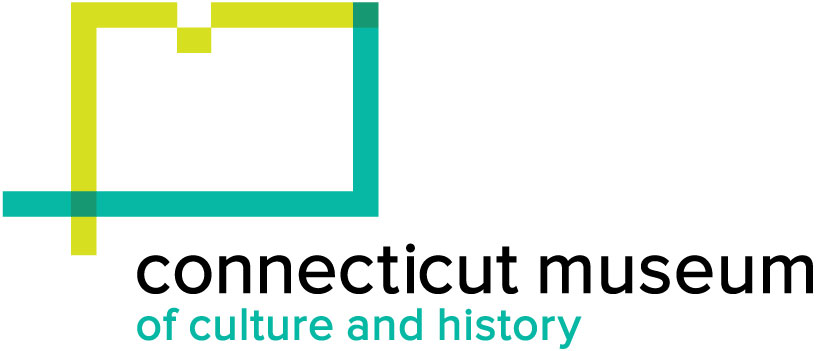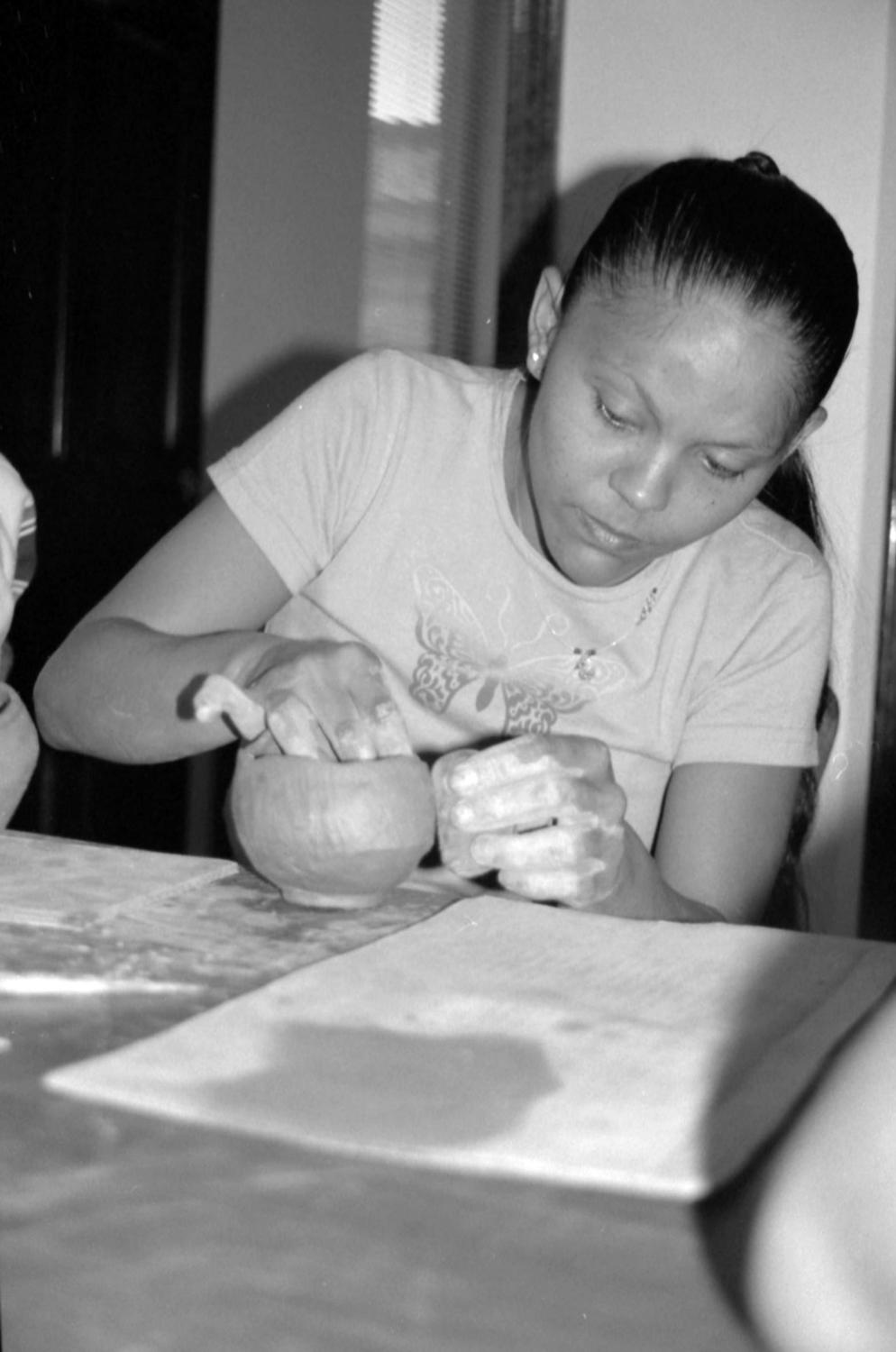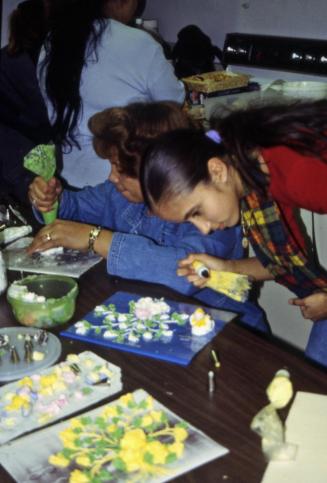Pottery, Cuatro, and Cake Decorating Workshops, 1999
SubjectPortrait of
Alice Chéverez
(Puerto Rican)
SubjectPortrait of
Vicente Valentin
(Puerto Rican)
SubjectPortrait of
Amelia Fonseca de Nuñez
(Puerto Rican)
SubjectPortrait of
Maria Ramos
(Puerto Rican)
SubjectPortrait of
Graciela Quiñones-Rodriguez
(Puerto Rican)
SubjectPortrait of
Melanio Gonzalez
(born 1951)
SubjectPortrait of
William Cumpiano
(Puerto Rican)
Date1999 July 19-August 6
Mediumfilm negatives strips
ClassificationsGraphics
Credit LineConnecticut Cultural Heritage Arts Program collections
CopyrightIn Copyright
Object number2015.196.339.1-.73
Description2015.196.339.1-.22, .26-.28, .38-.48 are photographs of the Alfarería Tradicional, Indigneous pottery workshops given by Alice Chéverez at ICR, July 26-30, 1999, with 19 participants.
2015.196.339.23-.25 & .29-.37 are photographs of a cuatro building workshop given by Vicente Valentin at ICR, August 2-6, 1999, with 11 participants.
Both workshops were produced by CCHAP in association with the "Mano a Mano: Puerto Rican Tradtional Arts From Island to City" exhibition held at ICR.
2015.196.339.49-.73 are photographs of a cake decorating workshop given by Amelia Fonseca de Nuñez at La Casa Elderly Housing on Park St., Hartford, July 19-23, 1999, with 10 participants.
These workshops were held in conjunction with the exhibition, "Mano a Mano: Puerto Rican Traditional Arts from Island to City."
(.1-.5) Alice Chéverez demonstrating making pottery by the coil method.
(.6-.7) Workshop participants making pottery.
(.8-.16) Alice Chéverez and translator Maria Ramos talking to a Girl Scout group visiting the Mano a Mano exhibit.
(.17-.18) Workshop participants making pottery. (.18) shows ICR Director Jean Schensul.
(.19-.20) Alice Chéverez instructing a young workshop participant.
(.21-.22) Pottery made by Alice Chéverez and workshop participants.
(.23-.25) Vicente Valentin instructing cuatro workshop participants. (.25) shows workshop assistant Graciela Quiñones-Rodriguez.
(.26) Mel Gonzalez working on pottery at the workshop.
(.27) Alice Chéverez working on pottery.
(.28) Workshop participants making pottery. ICR Director Jean Schensul pictured.
(.29) People participating in the cuatro workshop.
(.30) A workshop participant creating a cuatro.
(.31) A person using glue to build a cuatro.
(.32-.34) Vicente Valentin demonstrating cuatro-making technique. (.32) shows visiting cuatro maker William Cumpiano.
(.35) Waleska Arocho Ruiz building her cuatro in the workshop.
(.36-.37) Vicente Valentin instructing cuatro workshop participants.
(.38-.44) Alice Chéverez instructing participants in the pottery workshop. (.42) shows Lucy Fuentes.
(.45-.48) Workshop participants working on pottery.
(.49) Three people posing for a photograph in a kitchen as part of cake decorating workshop. Pictured left to right are Amelia Fonseca de Nuñez, instructor, unindentified, and Monica Fuentes.
(.50) A cake made with pastillaje as part of the workshop.
(.51-.55) Workshop participants working and their lunch break.
(.56-.65) Amelia Fonseca de Nuñez with a cake made during the workshop at the final day celebration. (.57) shows workshop assistant Graciela Quiñones-Rodriguez. (.60) shows Monica Fuentes, who was 14 at the time and participated in several workshops.
(.66-.73) Workshop participants working on the final cake.
NotesSubject Note: A locally-based team of Puerto Rican artists, in collaboration with CCHAP at the Institute for Community Research, Guakia, and the Crafts Development Office of Puerto Rico's Economic Development Department (PRIDCO), worked together to bring a multi-faceted program of Puerto Rican traditional arts to Hartford during the summer of 1999. "Mano a Mano: Puerto Rican Traditional Arts from Island to City," began with the July 1, 1999, opening at the ICR gallery of an exhibition of fourteen craft forms practiced in Puerto Rico. Later in the summer, five master traditional artists traveled from Puerto Rico to offer week-long workshops in their craft forms to the public. After the workshops ended, participants who wanted to continue working with their crafts were mentored by the local artists on the project team.2015.196.339.23-.25 & .29-.37 are photographs of a cuatro building workshop given by Vicente Valentin at ICR, August 2-6, 1999, with 11 participants.
Both workshops were produced by CCHAP in association with the "Mano a Mano: Puerto Rican Tradtional Arts From Island to City" exhibition held at ICR.
2015.196.339.49-.73 are photographs of a cake decorating workshop given by Amelia Fonseca de Nuñez at La Casa Elderly Housing on Park St., Hartford, July 19-23, 1999, with 10 participants.
These workshops were held in conjunction with the exhibition, "Mano a Mano: Puerto Rican Traditional Arts from Island to City."
(.1-.5) Alice Chéverez demonstrating making pottery by the coil method.
(.6-.7) Workshop participants making pottery.
(.8-.16) Alice Chéverez and translator Maria Ramos talking to a Girl Scout group visiting the Mano a Mano exhibit.
(.17-.18) Workshop participants making pottery. (.18) shows ICR Director Jean Schensul.
(.19-.20) Alice Chéverez instructing a young workshop participant.
(.21-.22) Pottery made by Alice Chéverez and workshop participants.
(.23-.25) Vicente Valentin instructing cuatro workshop participants. (.25) shows workshop assistant Graciela Quiñones-Rodriguez.
(.26) Mel Gonzalez working on pottery at the workshop.
(.27) Alice Chéverez working on pottery.
(.28) Workshop participants making pottery. ICR Director Jean Schensul pictured.
(.29) People participating in the cuatro workshop.
(.30) A workshop participant creating a cuatro.
(.31) A person using glue to build a cuatro.
(.32-.34) Vicente Valentin demonstrating cuatro-making technique. (.32) shows visiting cuatro maker William Cumpiano.
(.35) Waleska Arocho Ruiz building her cuatro in the workshop.
(.36-.37) Vicente Valentin instructing cuatro workshop participants.
(.38-.44) Alice Chéverez instructing participants in the pottery workshop. (.42) shows Lucy Fuentes.
(.45-.48) Workshop participants working on pottery.
(.49) Three people posing for a photograph in a kitchen as part of cake decorating workshop. Pictured left to right are Amelia Fonseca de Nuñez, instructor, unindentified, and Monica Fuentes.
(.50) A cake made with pastillaje as part of the workshop.
(.51-.55) Workshop participants working and their lunch break.
(.56-.65) Amelia Fonseca de Nuñez with a cake made during the workshop at the final day celebration. (.57) shows workshop assistant Graciela Quiñones-Rodriguez. (.60) shows Monica Fuentes, who was 14 at the time and participated in several workshops.
(.66-.73) Workshop participants working on the final cake.
This project was funded by the Lila Wallace Readers Digest Fund Community Folklife Program, the Roberts Foundation, the Greater Hartford Arts Council, the National Endowment for the Arts, the CT Commission on the Arts, PRIDCO, and the Institute for Community Research
Members of the project team were Melanio J. González, Pavlova Mezquida (PRIDCO), Glaisma Pérez-Silva, Graciela Quiñones-Rodríguez, Marcelina Sierra, Victor M. Sterling, and Lynne Williamson. Because of the knowledge and time needed to locate and purchase appropriate materials for the five workshops, ICR hired a local Puerto Rican artist, luthier Graciela Quinones Rodriguez, to help coordinate this important aspect as well as recruitment of workshop participants.
The project furthered many goals important to the team, including promoting awareness of the contributions of Puerto Rican artists, increasing access within the Puerto Rican community to training in art and entrepreneurial skills, and encouraging relationships across generations. The traditional arts and crafts of Puerto Rico remain vibrant and beloved, both on the island and in the new places where Puerto Rican people have settled. The project celebrated the strong cultural traditions remembered and practiced by so many in Hartford's large Puerto Rican community. Artistic, social, and cultural practices within Connecticut Puerto Rican communities show a regular and active maintenance of familiar traditions which link urban Puerto Ricans to the island, to which many return for visits. The primary goal of the project was to reinforce these patterns of cultural practice and remembrance. Other goals included: 1. To address the need for more public programming and education in Puerto Rican cultural expressions, both for members of this community and for general audiences; 2. To reinvigorate local Puerto Rican artists by connecting them with master traditional artists from the island who rarely visit the mainland; 3. To help preserve knowledge and practice of Puerto Rican traditional art forms; 4. To provide training and support for local artists who wish to begin or continue to develop an economic base for their artistic productions.
The exhibition drew from the work of master artists and their apprentices who participated in PRIDCO's Traditional Arts Apprenticeship Project. Through the Crafts Development Office of the Puerto Rico Industrial Development Company (PRIDCO), Puerto Rico hosts an island-wide training program in traditional arts. Law 166, first passed in 1986, mandates that five government agencies in Puerto Rico provide services to artisans for their education and for the marketing and promotion of their work. This enlightened policy recognizes that traditional arts contain great cultural value because they express the collective wisdom and the soul of a community of people. Traditional arts also represent a vital link to the past, as they are transmitted from one generation to the next through long-term, informal, one-on-one teaching between a master artist and a student. Learning an artistic form through the process of apprenticeship is a powerful way to pass on cultural knowledge as well as the craft itself; this process also helps to develop relationships across generations.
On display from July 1-October 1999, the exhibit was designed and installed by the same team which produced ICR's successful Herencia Taína exhibit in 1997. PRIDCO loaned art works from its Traditional Arts Apprenticeship project, featuring 16 important craft traditions practiced in Puerto Rico today. Traditions featured included: Marímbolas/Percussion Instruments; Panderos/Plena Tambourines; Volantines/Kites; Vejigantes/Coconut Masks; Hatillo Mascaras/Wire Net Masks; Artesanía en Lata/Tin Crafts; Talla de Gallos/Carved Roosters; Alfarería Tradicional/Indigenous Pottery; Encuadernación/Bookbinding; Papel Maché/Papier Maché; Talla de Santos/Saint Carvings; Estampas Típicas/Folk Houses; Tejido de Bejuco/Liana Weaving; Tejido de Enea/Cattail Weaving; Mueble de Mundillo/Lace Cushion and Holder; Bolillos/Bobbins; Mundillo/Lace.
Based on fieldwork in the Hartford community, ICR and Guakia added examples from local artists working in similar traditions. Based on research done by the PRIDCO's crafts apprenticeship project, Lynne Williamson edited, with PRIDCO and Hartford members of the project team, extensive bilingual labels explaining the art forms. The signage was produced by the Peabody Museum in New Haven. At the opening, which was a Greater Hartford Arts Council First Thursday event, the local cuatro group Amor y Cultura performed.
Puerto-Rican based artists giving workshops were: Angel del Valle - pandero making and playing; Amelia Fonseca - the art of cake decoration; Vicente Valentín - cuatro building; América Nieves - mundillo lace making; and Alice Chéverez teaching indigenous pottery making. Workshops took place at ICR and at locations in the Puerto Rican community. The trainings were free with some materials costs paid by participants; workshops were bilingual.
The weeklong workshops were intensive apprenticeship sessions designed for local artists who already had a level of skill in the tradition being taught or a closely related art form. The purpose is to develop further the skills of artists committed to a tradition so that they will be able to pass it on and perhaps market their work. The last day of each workshop was open to the public. The two music-oriented workshops (cuatro and pandero-making) celebrated with impromptu concerts by participants. Artworks by the teaching artists were displayed in the exhibit.
Two follow-up mentorships were conducted by local traditional artists – Ana Lozada in cake decorating, and Mel Gonzalez in clay art work. They met regularly with workshop participants, encouraging them to continue producing, offering further training in techniques of the art form if necessary, and advising on marketing procedures and outlets.
An unexpected benefit from the workshops was the degree of interaction between the participants, many of whom did not know each other before. CCHAP noticed that while they were engaged in the art forms, participants talked openly about their lives and issues important to them. Such workshops could be a useful setting for social or other research projects because people feel relaxed and informal (and in fact this outcome stimulated the development of CCHAP’s Sewing Circle Project in 2007). During the last session colleagues from Centro Civico, an arts and social service organization in Amsterdam, New York visited the project and became very interested in the potential for arts workshops to enhance communication and information gathering. Also, two of the workshops were held at La Casa Elderly Housing on Park Street, where the seniors showed a great interest in the art activities.
Proportionate to its size, Connecticut has one of the largest Puerto Rican populations on the mainland, especially in the major urban areas of Bridgeport, New Haven, Hartford, and Waterbury. People arrived from the island in great numbers after World War II to work in both factories and fields, especially eastern Connecticut's tobacco farms. Puerto Ricans in Connecticut are characterized by their migration patterns - they generally don't consider themselves "immigrants" or "settlers" in the state; they came here for work and continue to live here but frequently travel back to the island which they often view as a paradise, a homeland to which they belong and will return. Their nostalgia for the island is undoubtedly heightened by the difficult conditions many Puerto Ricans experience here, especially in cities: considerable prejudice, urban violence, poor schools, as well as high prices and taxes. An often-mentioned statistic compares Connecticut's per capita income, which is the highest in the nation, with its responsibility for four of the country's poorest cities - those listed above. Although large, the Puerto Rican community here is seriously underserved by local cultural, educational, and social organizations.
The community's love for the island and its culture has enhanced Connecticut's cities, especially Hartford, the location of this project's activities. Latinos, primarily Puerto Ricans, make up 35% of Hartford's population. The heart of the community is Park Street, the main thoroughfare in the Puerto Rican neighborhood known as Frog Hollow. Botanicas, bakeries, music clubs, bodegas, and restaurants named for Puerto Rican towns make this a vibrant center of constant activity. Artistic, social, and cultural practices within the community show a regular and active maintenance of beloved traditions which link urban Puerto Ricans to the island, and many return regularly for visits. The primary goal of this project was to reinforce the patterns of cultural practice and remembrance.
Biographical Note: Vicente Valentin of Vega Baja, Puerto Rico, is a registered traditional artist with the Programa Artesanal of Fomento Económico. He knows the entire process of making cuatros, from the selection and preparation of the woods to the specialized marquetry decoration to finish the piece. Usually he makes his cuatros from a block of wood, hollowing it out and building from this single base, using the traditional method of enterizo, hollowing out a block of cedar. But as with so many art forms, he has also adapted it to suit contemporary tastes and needs. For instance, cuatros made from a block of cedar tend to be heavy, and also take a long time to make. For the workshop he pre-assembled some parts of the cuatro, into kits that the participants purchased from Vicente. He then explained the entire traditional process, and then concentrated on teaching participants the mechanics of making the sounding board, which he considers the most important aspect. "The most important thing is that they get the fever and the basics, so they can go on and get fancy."
Biographical Note: Both Amelia Fonseca de Nuñez, of Carolina, Puerto Rico, and her sister developed an interest in "labores manuales" while growing up in Santurce, a working class suburb of San Juan. In Amelia's case she concentrated on cake baking and decorating, making special confections for friends and family from her early 20's. In Puerto Rico many young women attend local classes in their communities for various domestic crafts, and Amelia refined her decorative techniques in this way. She has continued to make cakes primarily for family celebrations and local events, getting business through word of mouth. Her specialty is pastillaje, handmade edible sugar paste decorations fashioned into flowers and shapes. She prefers to decorate cakes with "pasta laminada," a handmade edible sugar paste with a shiny finish that is worked into many different shapes by hand, like clay.
Biographical Note: Alice Chéverez, of Morovis, Puerto Rico, and her family are regarded as direct descendants of Taino Indians, the indigenous people of Puerto Rico. In the 1980s, they came to the attention of archaeologist and master potter Daniel Silva, who one day visited the family's home in Morovis asking for a drink of water while he was on an archaeological excavation. He taught Alice the techniques used by indigenous potters and since then she and her sister and mother have been creating replicas in their studio. Taino pottery was originally made by women for domestic and ceremonial uses. The pottery wheel was unknown; instead the Taino used the coiling method, where the object was modeled by rolling and stacking thin coils of clay and blending them together with the fingers. Many objects took the shape of animals, like frogs and turtles. Taino decoration is mostly geometric, consisting of parallel lines, dots and circles. The finished piece was polished with smooth pieces of gourd, allowed to dry and fired in a bonfire, a process that even today can take hours.
Biographical Note: Daniel Silva is a master ceramicist from Vieques, Puerto Rico, and is a specialist in the building and firing techniques used by Puerto Rico's indigenous people. He collects native clay, constructs pots by coil building, then fires them by the traditional foguera method in an open bonfire.
Additional materials exist in the CCHAP archive for these artists and events
Cataloging Note: This project was made possible in part by the Institute of Museum and Library Services MA-245929-OMS-20.
Status
Not on view




















































































